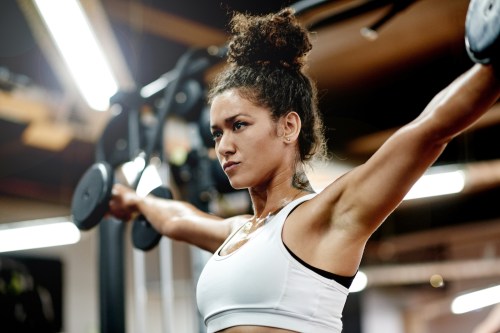We know that using weights in your strength training routine helps to build muscle, boost metabolism, and make it easier to progress in your workouts. While bodyweight training is great, lifting weights adds extra resistance, challenging your muscles and making you stronger—faster.
Experts in This Article
Sarah Brannon is a trainer and program fitness designer at Openfit, a fitness technology company.
“It’s so important to add weights into your workout routine to keep building muscle, regardless of your fitness goals,” says Sarah Brannon, an Openfit trainer and program fitness designer. As Theodore Savage, the fitness training director at Planet Fitness, previously explained to Well+Good, “Bodyweight exercises are great for maintaining strength gains or focusing more on muscular and cardiorespiratory endurance, but if your goal is to add strength or muscle mass, using the added resistance of weights is essential.”
But before you hit the weight rack (or invest in your own), Brannon stresses that weight lifting for beginners or pros alike isn’t just about curling dumbbells up and down. There are certain factors that you should pay attention to so that your workout is truly benefitting your overall strength (and even your overall mobility). Keep scrolling for the three weight training tips that she recommends you keep in mind for a more efficient and effective workout.
The three key weight training tips to know
1. Work in all planes of motion:
As we know, we don’t live our lives in just one plane of motion—and our workouts should follow suit. Multiplanar training is recommended by trainers since it gets your body moving in all different planes, which gives you more functional strength (aka strength that improves how easily you can perform the movements of your everyday life).
“Our workouts need to be functional and mimic movements we would do in life, which is something we do by incorporating movements in all three planes: transverse, sagittal, and frontal,” says Brannan. Transverse means your body is cut into top and bottom halves (think twisting motions); sagittal divides your body into right and left halves (moves that go forwards or backwards); and frontal is your body cut into front and back halves (side-to-side movements). Hit them all for a well-rounded workout.
2. Focus on all movement patterns:
Brennan notes that your weight training routine should touch on the primary movement patterns: squat, lunge, push, pull, hinge, twist, and gait. “This makes sure that you’re hitting all of your muscles so that your body is well-balanced,” she says. Use those staple exercises as a working guideline so you don’t over- or under-work one particular muscle group.
3. Decide on the sets and reps:
The number of sets and reps you do in your workout—and the level of weights that you use—all depends on your fitness goals. “If you are trying to get stronger, you will want to lift heavier weights while doing less reps,” says Brennan. “If your goal is to build endurance, you will want to grab lighter weights and knock out more reps.” Whichever route you take, she suggests choosing a weight that challenges you when completing all of your reps.
And if you’re just beginning to board the weight-training train? Start off lighter: “If you are a beginner, it’s always recommended to start with lighter weights and more reps so you can better understand form and also be able to adjust to the training stress on the body,” Roxie Jones, personal trainer creator of BodyRox, previously told Well+Good. The Mayo Clinic recommends newbies choose a weight that will tire your muscles in 12 to 15 repetitions.
Try this full-body HIIT workout that uses weights for some sweaty inspo:
Once you’ve finished up your session, don’t forget to stretch out. As celebrity trainer Toni Melaas previously told Well+Good, “Dynamic stretch is a natural companion to any weight training routine, offering your muscles a chance to breathe and expand, to improve your blood flow, and strengthen your connective tissue, all the while enhancing your postural alignment and range of motion.” Adding in just a few mobility moves after working with weights will prep your body for the next time you pick up those dumbbells.
Oh hi! You look like someone who loves free workouts, discounts for cutting-edge wellness brands, and exclusive Well+Good content. Sign up for Well+, our online community of wellness insiders, and unlock your rewards instantly.
Sign Up for Our Daily Newsletter
Get all the latest in wellness, trends, food, fitness, beauty, and more delivered right to your inbox.
Got it, you've been added to our email list.










